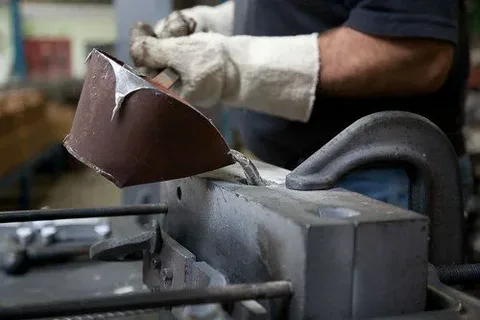In the world of manufacturing and industrial production, lathe machines and metal casting stand as two of the most essential processes that shape the foundation of modern industry. From automotive parts and machinery components to construction tools and aerospace equipment, these techniques ensure precision, strength, and reliability in every product created.
Both methods — machining and casting — have evolved over decades to deliver high-quality metal parts that meet the strict standards of durability, accuracy, and performance demanded by today’s industries.
Understanding Lathe Machines
A lathe machine is one of the most versatile tools used in metalworking and mechanical engineering. It operates on a simple principle: rotating the workpiece against a cutting tool to remove material and shape it into a precise form.
Whether producing cylindrical shafts, bolts, screws, or mechanical components, lathe machines are indispensable in machine shops, workshops, and manufacturing facilities across the globe.
Key Components of a Lathe Machine
- Bed – The base of the machine that supports all other components and ensures stability during operations.
- Headstock – Contains the motor and spindle that rotate the workpiece.
- Tailstock – Supports the opposite end of the workpiece and can hold tools for drilling or reaming.
- Carriage – Moves the cutting tool along the surface of the material.
- Chuck – Clamps the workpiece securely in place.
- Tool Post – Holds and adjusts the cutting tool for precise shaping.
Types of Lathe Machines
Depending on the specific application, several types of lathe machines are used in the industry:
- Engine Lathe – The most common type, used for general-purpose turning, facing, and drilling.
- Turret Lathe – Designed for repetitive production of identical parts, often used in mass manufacturing.
- CNC Lathe Machine – Controlled by computer numerical systems for high precision and automation.
- Bench Lathe – Compact and used for small workpieces or precision instrument work.
- Tool Room Lathe – Built for high accuracy in tool manufacturing and prototype work.
Applications of Lathe Machines
Lathe machines play a critical role in shaping and finishing metal components for numerous industries:
- Automotive: Manufacturing crankshafts, brake drums, and axles.
- Aerospace: Producing precision components for engines and landing gear.
- Construction: Fabricating bolts, nuts, and pipe fittings.
- Energy Sector: Creating turbine shafts and generator components.
- Medical Equipment: Turning surgical instruments and precision parts.
The precision, versatility, and durability of lathe machining make it one of the cornerstones of modern engineering and manufacturing.
Introduction to Metal Casting
While lathe machining shapes metal through removal, metal casting forms it by pouring molten metal into a mold. This process allows manufacturers to create complex shapes that might be impossible or uneconomical to achieve through machining alone.
Casting is one of the oldest known manufacturing methods — dating back thousands of years — and remains one of the most efficient ways to produce strong, durable components on a large scale.
The Metal Casting Process
The metal casting process involves several key stages:
- Pattern Making – Creating a model of the part to be cast using wood, plastic, or metal.
- Mold Preparation – Constructing a cavity (usually from sand, ceramic, or metal) based on the pattern shape.
- Melting and Pouring – Heating the chosen metal (iron, aluminum, steel, etc.) to its melting point and pouring it into the mold.
- Cooling and Solidification – Allowing the molten metal to cool and solidify within the mold.
- Shakeout and Cleaning – Breaking the mold and cleaning the cast piece of sand, scale, or residue.
- Finishing and Inspection – Machining or polishing the casting to meet precise dimensional requirements.
Types of Metal Casting Methods
Different metal casting techniques are used depending on the application and metal type:
- Sand Casting – The most traditional and widely used method for both ferrous and non-ferrous metals.
- Die Casting – Uses high pressure to inject molten metal into metal molds, ideal for mass production of aluminum or zinc parts.
- Investment Casting – Also known as “lost wax casting,” it provides excellent surface finish and dimensional accuracy.
- Centrifugal Casting – Commonly used for cylindrical parts like pipes and bearings.
- Permanent Mold Casting – Reusable metal molds that offer consistency and high-quality results.
Advantages of Metal Casting
- Complex Shapes: Can create intricate designs that would be costly to machine.
- Wide Material Range: Suitable for cast iron, aluminum, bronze, brass, and steel alloys.
- Cost-Effective: Ideal for producing large quantities of identical parts.
- Strength and Durability: Cast components withstand high pressure, heat, and wear.
- Design Flexibility: Allows modifications and integration of multiple parts into a single casting.
The Connection Between Lathe Machines and Metal Casting
Although lathe machines and metal casting are distinct processes, they often complement each other in industrial manufacturing.
- After a metal casting process, the raw cast part usually requires machining to achieve exact dimensions, smooth surfaces, and precise holes or threads.
- Lathe machining refines the rough casting, ensuring perfect balance, alignment, and fit for its intended use.
For example, an automotive engine block is first produced through metal casting, and then critical areas such as cylinder bores and crankshaft journals are finished using lathe machines and CNC equipment.
This combination of casting and machining ensures a perfect balance between efficiency and precision — producing strong, cost-effective, and high-performance components.
Modern Innovations in Lathe and Casting Technology
Modern manufacturing has seen significant advancements in both lathe machines and metal casting:
- CNC Automation: Computer-controlled lathes provide unmatched accuracy and repeatability.
- 3D Printing in Casting: Used for creating molds and patterns quickly and efficiently.
- Advanced Materials: New alloys improve strength, corrosion resistance, and heat tolerance.
- Eco-Friendly Practices: Foundries are adopting sustainable melting processes and recycling scrap metals.
Together, these innovations enhance productivity, reduce waste, and ensure environmentally responsible manufacturing.
Industries That Depend on Lathe and Casting
- Automotive Manufacturing
- Aerospace and Defense
- Oil and Gas Equipment
- Power Generation
- Marine and Shipbuilding
- Industrial Machinery
Both lathe machines and metal casting play irreplaceable roles in producing the high-performance parts that keep these industries operating efficiently.
Conclusion
From the precision of lathe machines to the versatility of metal casting, these technologies form the foundation of modern manufacturing and engineering.
Casting provides the shape — machining gives it precision. Together, they create components that power vehicles, machinery, and entire industries.







